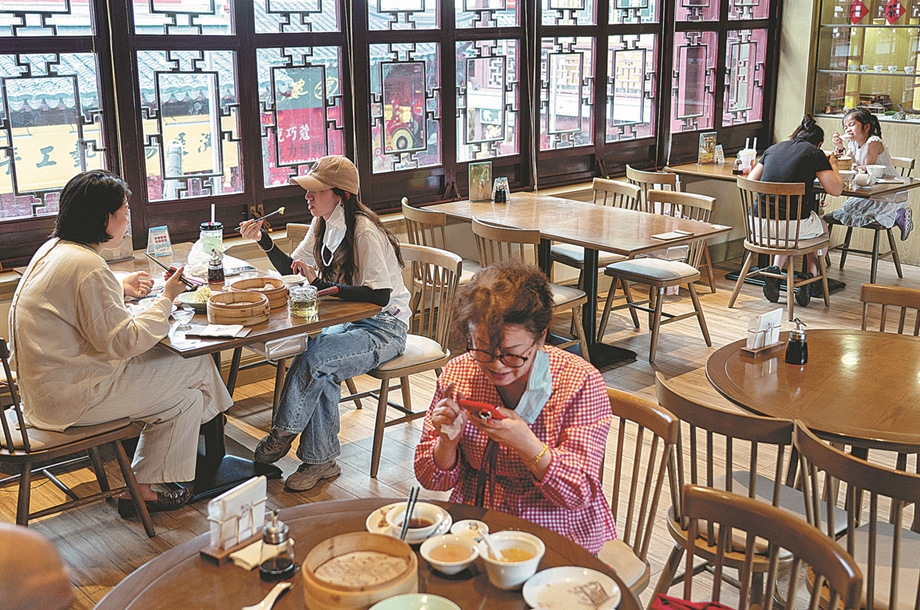Shanghai diners savor resumption of service
 Customers enjoy a meal at a steamed bun restaurant in Shanghai's downtown Huangpu district on Wednesday, as dine-in services resumed in the city. [Photo by GAO ERQIANG/CHINA DAILY]
Customers enjoy a meal at a steamed bun restaurant in Shanghai's downtown Huangpu district on Wednesday, as dine-in services resumed in the city. [Photo by GAO ERQIANG/CHINA DAILY]
Restaurants and hungry diners in Shanghai embraced dine-in service for the first time in three months on Wednesday in the latest recovery after an outbreak of COVID-19 shut the city down.
As expected, the return of on-site customers brought excitement and hope to the catering and hospitality industry, but many strict precautions had to be taken, such as limiting capacity and daily nucleic acid tests for staff.
At around 11 am, Pang Yiwen and his seven colleagues were among the first diners at a downtown outlet of popular hotpot chain Haidilao.
"Eating in the restaurant you get more service, which Haidilao is famous for," Pang said. "After all, it's been three months without dine-in, we were all dying for a big feast."
Cheng Wei, manager of the outlet, said reservations and inquiries had flooded in since the city government announced the resumption of dine-in service.
"We have 20 percent more reservations for the coming days than in early March," said Cheng.
"And we've launched a new summer dessert to welcome our lovely guests."
The hotpot chain had made many preparations, such as redesigning the service flow to meet epidemic control protocols and having staff take COVID-19 tests daily. Before the reopening, 40 outlets were inspected and approved by the city's health and market authorities.
In Shanghai tourist spot Yuyuan Garden, time-honored restaurants including Nanxiang Mantou and Lu Bo Lang opened their doors to patrons again on Wednesday as well.
After showing her negative nucleic acid test at the entrance, Chen Peili, a retired doctor, got together in Nanxiang Mantou with her friend, who is a retired nurse. They ordered the famous steamed buns and spring rolls.
"The restaurant gives discounts for volunteers during the past COVID-19 outbreak, and I happened to be one at my community, so it made me very happy," Chen said.
The restaurant has also limited the number of guests to half capacity, and provided serving chopsticks and spoons for each diner.
Huang Rong, deputy general manager of Lu Bo Lang, said they require every worker to take both a nucleic acid test and antigen test every day, and only opened its second floor for service.
"It's good news for all of us in the hospitality industry," said Huang. "But we have to cherish it with stringent safety measures."
Wang Ningning, manager of Fika Waka restaurant, echoed Huang's excitement. "Resuming the dine-in service allows us to provide customers with a better dining experience.
"We've had tons of customers come in and ask when we can eat inside. It's not only the catering staff but also the customers who are looking forward to the day when catering returns to normal," she said.
High-end restaurants and luxury hotels were also ready for dine-in. Yao Min, founder of 102 House, a high-end restaurant specializing in Cantonese cuisine, said, "The whole kitchen has been waiting for this day to come, and I've really missed the lively scene in the restaurant."
The restaurant has provided food delivery since early June, but resuming dine-in was critical for high-end restaurants, which emphasized dining atmosphere and the freshness of food.
The Heavenly Jin of J Hotel, the highest restaurant in a building certified by Guinness World Records, and the Cathay Room &Terrace of the Fairmont Peace Hotel on the Bund had put out welcome fliers on Monday, and reservations have to be made days ahead to secure a table, according to the hotels.
Many small restaurants are still waiting to be approved to open by authorities. It is also taking time for customers to fully return to normal.
"Many customers still don't know about the reopening of dine-in," said barista Mickey Zhu of Buna & Pate, located in the AI Plaza shopping mall in Xuhui district.
"Although we published the announcement on our official account and in the WeChat group, a guest still went outside to eat his bread and drink his coffee this morning until we invited him to come in," he said.
Zhu revealed that dine-in accounts for up to 90 percent of their turnover. Many distinctive products and services can only be served on site.
"The guests can watch us making coffee in the store, especially the hand-drip. A comfortable seating environment is also important. If customers just order a cup of Americano or latte and take it away, we will be much less competitive with other coffee chain brands," Zhu said.